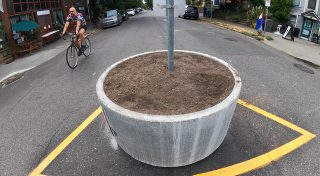
Last week’s announcement that the Portland Bureau of Transportation will install 80 concrete barrels on neighborhood greenways is a major step forward. After taking a closer look at a few installations over the weekend, I’m convinced these additions to our traffic calming arsenal will have having a big impact on safety and stress levels.
To refresh, these barricades are the next step in making PBOT’s ‘Slow Streets’ network more permanent. The Slow Streets emerged at the height of the Covid lockdown in 2020 as a way to facilitate safe outdoor mobility when a high volume of walkers, bikers, and rollers took to neighborhood greenways. Unfortunately, the initial step was rather anemic. The signs were frequently moved and/or hit and damaged by people who either didn’t want them in their way or who were unable to drive around them.
I visited several installations on Southeast Salmon, one on SE Stark, and one on Ankeny on Saturday and came away very impressed. Watch our latest video below and read why I think these are new concrete barrels are such a game-changer for Portland’s existing network of neighborhood greenways:
Advertisement
— At about four-feet in diameter and three-feet high — and full of soil — these barrels are heavy and take up a lot of space. On relatively narrow residential streets, this gives them a strong presence that competes much better with cars than a-frame signs and lightweight plastic barrels. Street safety is all about power. In situations where people feel they have limitless power, they drive more dangerously, take more risks, feel more entitled, and so on. When we take that power away by introducing something just as powerful and intimidating as they are — like a massive concrete barrier — drivers tend to behave much better. These concrete barrels equalize the power dynamic and provide a level of security for vulnerable users.
— As you enter the intersection on a bike, the barrels are like a shield against oncoming traffic. Similar to how curb extensions work for walkers on a sidewalk, these barrels allow bike riders to nose further out into the intersection, thus shortening the crossing distance.
— The 15 mph signage (and “Shared Street” iconography) is another hint to drivers that they’re entering a special place. Note that these are yellow advisory signs, so they aren’t legally binding. PBOT says their goal for these signs is for people to slow down while turning into a greenway and “have greater awareness that this is a shared street and that more pedestrians and people on bikes will be present.”
— The barrels are placed in the middle of the greenway street and are staggered from one side of the street to the other. This increases visual impact as you drive up to an intersection. The barrels also have the effect of narrowing the larger cross-street, which slows drivers down.
— One of the biggest impacts is how the barrels change driver turning movements. The presence of a large obstacle in the middle of the street forces drivers to make more deliberate, careful turns with sharper radii. They can no longer just roll straight through and/or lazily cut a corner.
— At a cost of just $1,500 to $3,200 per installation, these things are very cheap. And unlike a median island (which has similar benefits), they can be moved if necessary.
— We cannot underestimate the cumulative impact. Portland’s greenways already have a good bit of traffic calming infrastructure like speed bumps, roundabouts, diverters, medians, sharrows, signage, 20 mph speed limits, and so on. The addition of these barrels will further limit driving access and add to the inconvenience, frustration, and reduction in power that is so important to creating truly low-stress, family-friendly streets.
— The concrete barrels are a powerful complement to intersection daylighting, where PBOT prohibits parking within 20-feet of a curb to increase visibility.
I’m really excited about these! They’ll look even better when folks plant and paint them.
PBOT says all 80 of the barrels planned in the initial roll-out should be installed by mid-fall of this year. Check the map to see if any are coming to your neighborhood. And if not, you can request one by emailing PBOT Slow Streets program manager Scott Cohen at scott.cohen@portlandoregon.gov.
— Jonathan Maus: (503) 706-8804, @jonathan_maus on Twitter and jonathan@bikeportland.org
— Get our headlines delivered to your inbox.
— Support this independent community media outlet with a one-time contribution or monthly subscription.



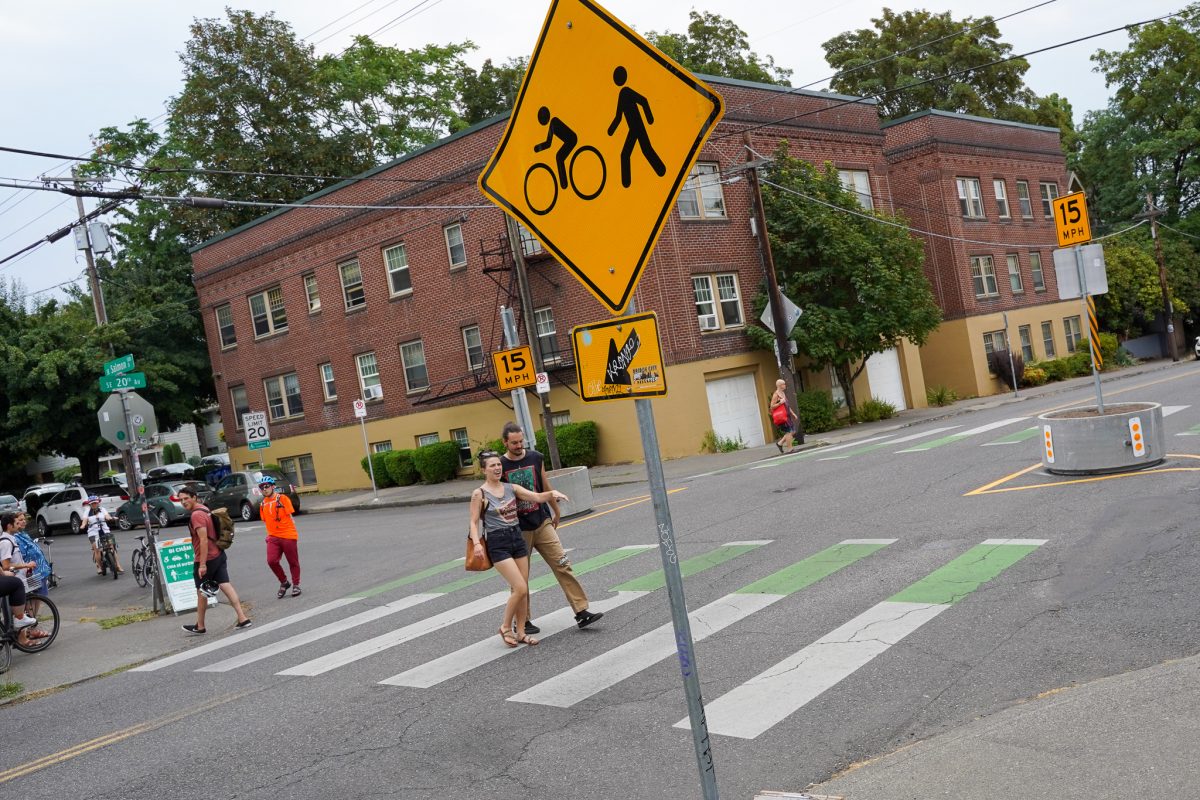
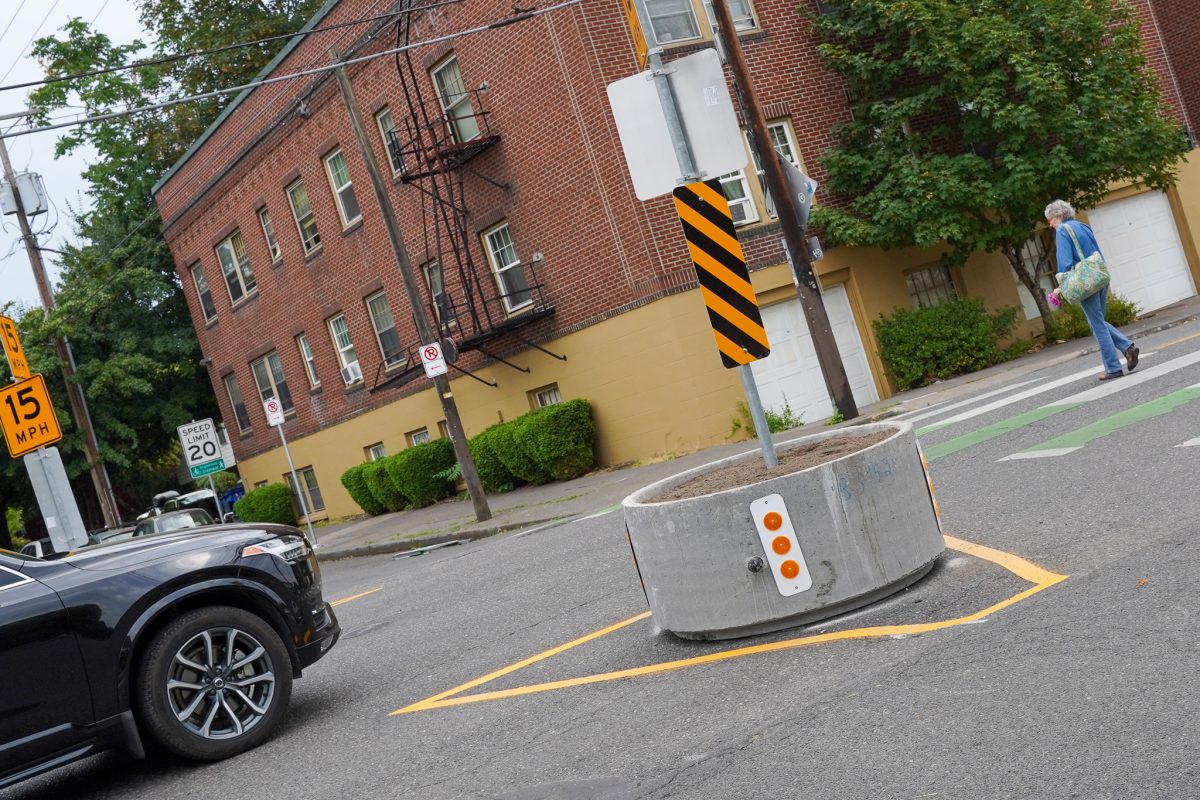






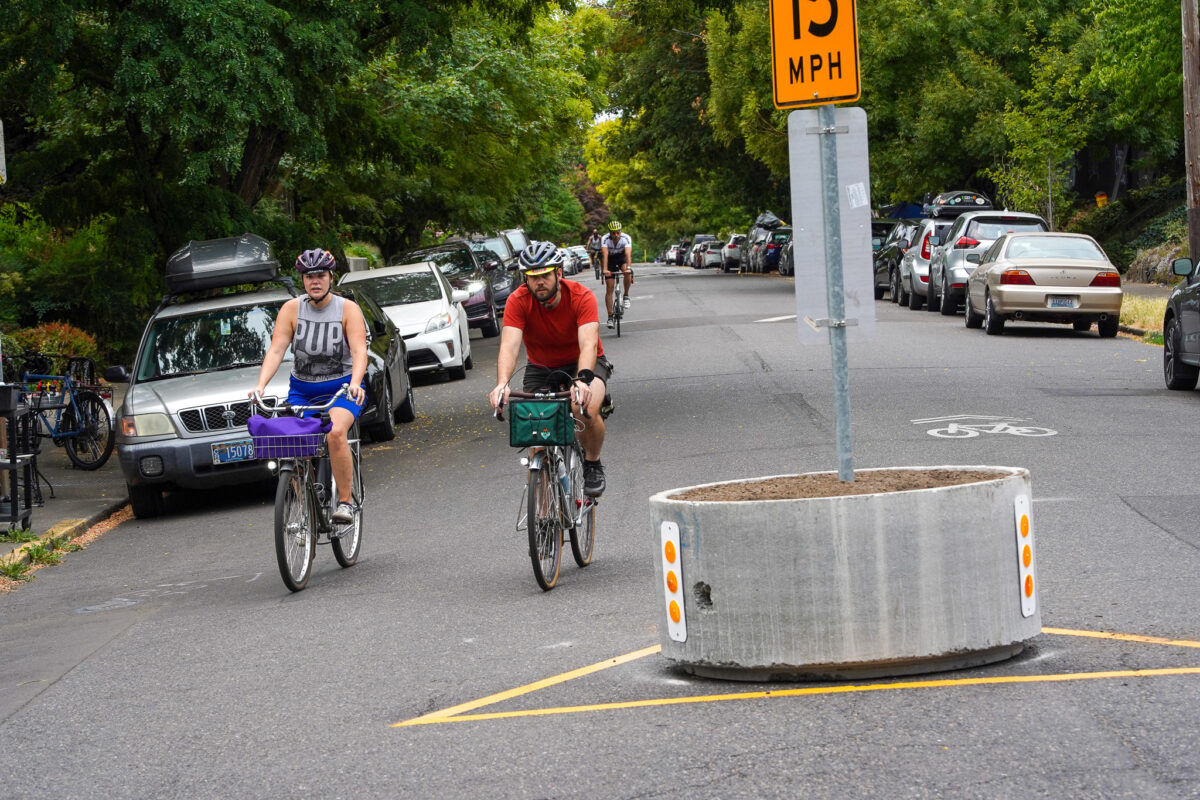


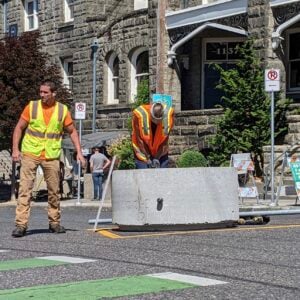



Thanks for reading.
BikePortland has served this community with independent community journalism since 2005. We rely on subscriptions from readers like you to survive. Your financial support is vital in keeping this valuable resource alive and well.
Please subscribe today to strengthen and expand our work.
NICE VIDEO!!!
Really like the video Jonathan and really appreciate the daylighting.
I wnder how many of these could be installed around Portland for the $800 million budget of the Rose Quarter project?
These are going to save lives!
Two things:
1. Enforcement, Enforcement, Enforcement. Concrete barrels are not helping the underlying problem. Can we all admit that the only reason these are necessary in the first place is that today’s drivers are emboldened to drive fast and break things because there is literally NO traffic law enforcement. I would not have a problem with traffic on a greenway if it was driving the SPEED LIMIT (20) and not using their cars as tools of aggression.
2. The failure to fashion easily discernible rules around deployment and kind of diverters will and is resulting in driver frustration. I know this is not a popular take on BP but most of us are also auto drivers and the result of the breaking of the street grid only results in more traffic concentrated on arterials which results in more delay and more aggressive behaviors, law breaking and flagrant disregard for prohibitive signage. Certain destinations in NW Portland are downright impossible to navigate without aid of GPS.
I don’t know, I guess it depends. Real diverters maybe but PBOT is adamantly against installing them on greenways because they want to preserve motorists’ ability to use greenways as cut through routes.
Now these things? I don’t think 99% of drivers will even realize what they are for. They don’t impede motorist, make them change route, or really force them to slow down.
I think overall the physical features of a street have a far greater and more consistent impact on driver behavior than law enforcement. So no, I wouldn’t cite driver emboldenment as the only (or even the primary) reason we need concrete barrels. And I’d argue they are absolutely helping the underlying problem, which is that the built environment is built in a way that frequently prioritizes drivers’ convenience at the expense of the safety of people on bikes or walking.
Portland drivers over the last 20 years have become increasingly hostile to anything and anyone in their way. There are no consequences to driving recklessly. Heck, I just read last night that “street racers” blocked the entire intersection of MLK and Columbia for 3 (!!!) hours and no police responded because that is their policy now.
People intentionally driving through stop signs, red lights, ignoring one-way diverters, no-passing zones. I could go on and on, we as bike riders are uniquely vulnerable but we have a do-nothing city council, police commissioner, DA and Portland Police who have basically enacted a work slowdown because their feeling were hurt last year.
These are problems concrete barrels don’t fix.
Yep lawless drivers abound in PDX.
https://www.koin.com/news/street-race-blocks-ne-portland-intersection-for-hours/
You’re correct that these concrete barriers won’t make it literally impossible for the worst 5% of drivers to continue with their over-the-top recklessness – although I bet they’d serve as a pretty good drifting/sliding deterrent. Seriously though, street racing does seem like an example where law enforcement is the better tool for the job. Apples and oranges, sort of.
I think if we’re talking about more run-of-the-mill bad driving, this treatment does potentially make a big difference. I.e., it encourages good behavior (slowing down while crossing an intersection, slowing down before making a turn, turning more deliberately) by making the inverse bad behavior (driving fast, turning without looking or slowing down sufficiently) more difficult. And in combination with other traffic calming features, I have to think it’d also make the street less attractive for cut-through traffic – another good thing.
Can we imagine a world in which the police are not responsible for fixing this problem? I agree that more and better enforcement of current traffic laws would help. But we don’t live in that world and wishing for it isn’t going to change a thing. It’s time to start visualizing a city and community where creativity and citizens are the solution.
Also, most motorists can and should drive less. THAT’s the “underlying problem.” all those single occupancy vehicles heading to NW to go boutique shopping is not something the police should have to add to their list of priorities.
I personally don’t understand these things at all. They stick out from the sidestreets, out into the actual arterial traffic lanes, meaning a vehicle is going to hit one just going straight. They are not physical diverters, meaning they do absolutely nothing to actually prevent traffic from turning onto the said sidestreets they are aimed at heoretically protecting. They just seem a little… useless. Please somebody educate me. I personally would come out in the middle of the night with 15 friends and move them, so that they actually formed a diverter!! 😉
Did you watch the entire video? Both of your points are addressed in it. They do not “stick” out into the cross street. They only stick out when you are trying to continue straight on the greenway, and that’s the whole point.
These planters do occupy space in the roadways orthagonal to neighborhood greenways, many of which are collectors or arterials. Typically they occupy the deeply-subsidized public space that is used to store the private cages of homeowners.
I expect quite a few “accidents” involving planters on collectors/arterials where there are insufficient parked cages to adequately “protect” planters from the malice of inattentive cage users.
I don’t think these planters are going to be any more effective than PBOT’s failed traffic circles and they may ultimately prove to be sites of bike-cage conflict (just as for traffic circles). For example, I’ve already experienced dangerous passes in planter-adjacent space on my morning work commutes.
The fact that PBOT chose to install this type of bizarre experimental facility instead of proven half or full diverters is illustrative of the rapid decline in the sociopolitical power of transportation cycling in Portland.
“Cages”… As soon as I see this word, I move on to the next comment. Thank you for saving me some time.
you would only hit one if you were A: On your phone and clueless about where you were pointing, B: driving too fast and couldn’t stop in time, C: Drunk or high.
So yea, they’re working.
These beg barriers aren’t going to slow down motorist, they aren’t going to discourage motorist from speeding on greenways, and they wont discourage or prevent motorist from using greenways to cut through.
These are “greenways” and we can’t even get our faux-gressive transportation agency to get our ‘greenways’ just restricted to localized motorized traffic. Thousands of miles of roads in Portland and motorist apparently need unlimited access to every single foot. It’s a pathetic effort from a pathetic agency that stopped carrying about pedestrians and cyclists years ago if it ever truly did.
The video evidence above contradicts your assessment. Multiple drivers are seen slowing down to go around the barriers.
And what happened ten feet after they passed the beg barrier? It’s a gas propelled machine. Slowing them down for 2 seconds means nothing when they can get back up to 30 in five.
It means something.
The plastic barriers on SE Gladstone, which I drive through far more often than I bike through, absolutely force me to slow down and drive carefully. Given that drivers turning onto Gladstone (greenway) from 52nd (major thoroughfare) used to take that at speed, cutting the corner and plowing right through both lanes of Gladstone, any barrier helps. But the plastic barriers are regularly out of position for some reason; I look forward to a barrier that’s harder to argue with.
If they’re as ineffective as you say, why would PBOT go ahead with converting the temporary signs to these barriers? This program over the last several months just served as a real-world test. I don’t see PBOT going ahead with these planters if the temporary signs achieved nothing.
Uh, because PBOT is prone to taking actions that they can brag about but provide no actual benefit? Do you really think PBOT makes decisions based on how effective something is?
These are cheap solutions that allow PBOT upper management and planners to flash their bike-friendly bonafides at the next planning conference or job interview. That’s why these are going in. If PBOT was actually interested in calming ‘greenways’ they would put hard barriers in, which is an evidence-based action as opposed to yet another ‘experiment’ from PBOT.
I haven’t seen any data indicating it produced calmer streets. I know that the ‘greenway’ near me has gotten more dangerous, with more cut through traffic and faster speeds since the beg barrier went in. Is there some supporting data I’m missing?
Then you simply don’t know PBOT.
“If they’re as ineffective as you say, why would PBOT go ahead with converting the temporary signs to these barriers?”
Because PBOT is unwilling to implement proven effective traffic calming infrastructure and uses these ridiculous cheap experiments to performatively mollify cycling enthusiasts (who largely appear to be oblivious to the decline in transportation cycling in this community).
Ahh the infamous circular firing squad among American cyclists lives on! So Soren, cycling enthusiasts are another breed entirely who are oblivious to what commuter/utility cyclists experience? This kind of either/or stereotyping of other cycling groups is old, petty and counterproductive. Raged for years between road and mountain bike “communities” too, and was equally tedious. Please leave small minded generalizations of cyclists outside of your “tribe” off this forum. Many, many cycling enthusiasts are also daily citizen cyclists as well – I’ll say Jonathan Maus is one of them, and don’t think he’ll mind. (Jonathan?) Soren gets these digs in regularly to those cyclists outside of the bubble Soren inhabits. Maybe you can go after e-bike riders too? I ask you to please give it a rest, we don’t need this kind of negativity in an already marginalized and stigmatized subsection of American culture. (i.e. everyone who rides bikes) Thanks.
Does PBOT have any quantitative data to demonstrate to efficacy of the slow streets program? If they have it, I haven’t seen it. I’ve done a lot of biking on greenways in the last year and a half, and I haven’t seen any sort of systematic deployment of traffic counting devices to measure the impact on vehicle cut through traffic. The only thing that PBOT has used to explain why they are continuing with the slow street program that I’ve seen is that they claim to have a large number of comments, the majority of which they claim to be positive in tone.
You are giving way too much credit to PBOT to just assume they have any evidence to support the continuation of this program.
There is an evaluation of the ‘Safe Streets’ program
https://www.portland.gov/sites/default/files/2021/safestreets-evaluation-publicreviewdraft-march-2021.pdf
There are some pretty troubling issues with that report though. The survey has ambiguous questions such as “Do you feel a stronger sense of community along these Slow Streets”
“…as well as those in North and Southwest Portland felt there was a stronger sense of community along the Slow Streets”
Stronger than what? Stronger sense of community than when you walk down Lombard? Stronger sense of community than other neighborhood streets? Stronger sense of community on ‘greenways’ over non-greenways? Stronger sense of community than before the ‘Safe Streets’ program started? Who knows. Perhaps the question was phrased more meaningfully on the survey and they truncated it here.
Even if it was clearer what was being asked here, we don’t have a before sample so we don’t have any idea how the beg barrels changed responses.
Now, onto the traffic counts. Unless they are holding something back, the latest traffic counts for the ‘Slow Streets’ program are from a year ago in July of 2020 when traffic was down generally and many employers were still fully work from home. I don’t know about other ‘greenways’ but N Central motorized traffic is drive heavily by cut through commuter traffic going from Highway 30 to I-5 north and cut through commuter traffic trying to avoid N Lombard.
It’s damning that bike traffic fell significantly on all of the ‘Slow Streets’ that featured major bike volume. Perhaps the traffic change has zero to do with the ‘Slow Streets’ program and everything to do with the global pandemic? I’d like to see them measure this again.
They don’t include any speed data but they indicate they collected it. I’d be curious to see what happened to speed because the ‘Slow Streets’ program should have, if PBOT’s theory is correct, slowed down those that were still driving on the ‘greenway’ regardless of volume.
On SE Lincoln Street at 52nd Avenue, vehicle traffic was down 49% and bike traffic down 76%.”
Wow…those are awful numbers and conform with my anecdotal impression that transportation cycling has really cratered in Portland.
Survey responses by geography:
East Portland: 0.5%
South East: 30%
North East: 24%
It’s disgraceful to even publish a survey that is so thoroughly biased.
These planters are a huge improvement. They’re big, physical barriers. You can see and almost feel the safety improvements while watching Jonathan’s excellent video. Of course we all want more, but I think we should celebrate moving the ball forward. This is a big win. Be happy.
Love seeing these around. I can’t impress to BP readers and folks just how CHEAP these are compared to even adding a curb extension or traffic median. Just shows how we can get big results for little $$$.
At the same time I’m scared PBOT is gonna pat themselves on the back and walk away, just like the greenways before the pandemic. These barriers should be a phase 1 approach to more permanent and imposing infrastructure. We need to solidify greenways, commit to having greenways be seen, and double down on people being prioritized in Portland.
Also if you drive a car and get frustrated by these: Cool. Thats the point.
These are good for drivers, too. The few intersections near my house where there are plastic barriers now have always been a nightmare – narrow greenways connecting to multi-lane, fast-moving streets. Drivers turning in and out of the greenway have always been scary, whether I’m driving or biking; more than once I’ve been halfway into a turn into the greenway only to have a driver trying to turn left out of the greenway occupy the lane I’m turning into. Now they will get a narrow, well-defined lane they physically have to be in, so they’ll be far more predictable.
This is good for drivers and bikers alike.
I wonder if there will be any future ability to add some Neighborhood Greenway advertisement to the concrete barrels. It would be excellent for drivers passing by to see an inviting green sign that might just engender a desire to get out of their cars and check it out.
I don’t think most automobile drivers actively go out of their to drive on a greenway. They do it because it is often better than the alternative, which is sitting in traffic on parallel streets or going on a different street with lots of stop signs. They do it because Waze tells them to. They do it because they live on the street or their neighborhood school is on a greenway. The new barriers will likely be a minor inconvenience for some people and keep them off the greenways. For others, they won’t be enough to deter them from greenway driving.
Could they be a gateway drug to permanent diverters that actually are designed to prevent driving? One can only hope.
It appears the “Shared Street” iconography only appears in the PBOT design renderings but not in the real world implementation. (At least not in any of the photos or video.) Why did PBOT pull that out of the project?
I’d like to know the answer to that also. The Shared Street signage would be particularly helpful on streets that don’t have sidewalks.
Every time I finish a BICYCLE ride I am so thankful I didn’t run into something designed for auto traffic control or routing.
at least these temporary barrels are higher and easier to see and avoid on your bike than curbs and other low profile permanent hardscape!
I think these are a great addition to the tool kit for slowing drivers (please install at the intersection of Rodney & Russell). I would love to see PBOT add $300-500 per barrel to work with local artists to spruce these up with some paint. The Regional Arts & Culture Council has a muralist roster (a diverse group of vetted visual artists) and it seems likely they could partner with PBOT to provide opportunities for artists that also increase the visibility of these diverters and promote/support other goals (bike visibility, placemaking, history, fun, etc.) Concrete is good; concrete + community is even better 🙂
I live on Ankeny & I love them. It’d always be better to fully divert traffic, like on 15th or 21st & Ankeny, but they handle what I see as a huge problem with greenways: accidental speeding. PBOT tend to remove stop signs on greenways, which is great, but I’ve noticed most drivers will naturally just keep going faster & faster on a 4+ block stretch without stop signs. Putting something in there that allows the bike to keep going but makes the driver wake up & pump the breaks is a huge benefit.
Jonathan–I really like your mini video reporting of infrastructure installations.
Good work!
Paint them red and advertise Watney’s Red Barrel.
Looks like these things will slow down some automobiles, and also will cause some drivers to drive on the opposite side of the street to keep going the same speed, and to make left turns, thus possibly causing head-on collisions.
I have lived in Portland my whole life, been biking Portland’s streets for over four decades, was flying down NE Fremont Street from 33rd to 27th on a BMX bike, sans helmet, at age 8, biked all over downtown Portland on a ten-speed by age 14 in the middle of busy streets with traffic around me. One of the benefits of living a big city, not a suburb, especially in Portland, is having a grid pattern of streets, thus allowing people to save time by being able to drive down all sorts of streets to get where they need to go. In suburbs, you have endless cul-de-sacs and housing developments with areas with no outlets, and the major streets end up with traffic backed up for a quarter-mile to half-mile during rush hour times in some areas, especially Beaverton. By installing traffic diverters and making it so cars can’t drive down side streets, it is only making traffic worse on other side streets and on busy streets, and causing drivers to become more angry and aggressive.
I am all for biking and didn’t even have a drivers license til I was 23 years old, and my bike was my main mode of transport most of my life, until I started having to work in Hillsboro while living in North Portland. (I refuse to live out in Hillsboro or Beaverton, I’d rather kill myself.)
The longer cars sit in traffic, or take to drive from place to place, the more air pollution they create. Due to weather and climate, Portland will never have more than about 15% of people commuting by bike — it’s a simple fact of life, no matter how much we think that can be overcome.
Overall, I think these things are a waste of money. How about fixing the potholes all over town, or paving side streets in Cully and outer East Portland, or installing sidewalks on busy streets in Cully and outer East Portland.
Bicyclists need to learn how to ride with vehicle traffic around them. I did as an 8 year old. People can do it. PBOT needs to spend less on bike infrastructure and more on helping the poor, low-income areas of East Portland and Cully get actual sidewalks, paved streets and bike lanes painted.
People in inner SE Portland can bike around just fine without these things. Buck up, people!
Complete agree, these things are so simple yet so awesome and effective. Excellent work PBOT!
All fine and dandy, until you need a big fire truck to take that tight 90 degree corner around one of them concrete barriers in a hurry… There is a reason why streets are built a little bigger than ox carts. Don’t get me wrong, I am all for doing miles of protected bike lanes with concrete jersey barriers, but restricting turning circles in an intersection is kinda counterproductive.
Do you know why they removed the barriers from Salmon over the weekend?
No cause for alarm, PBOT says. Will confirm details soon but it appears to be part of a project and the barriers will return or be replaced w something more permanent.